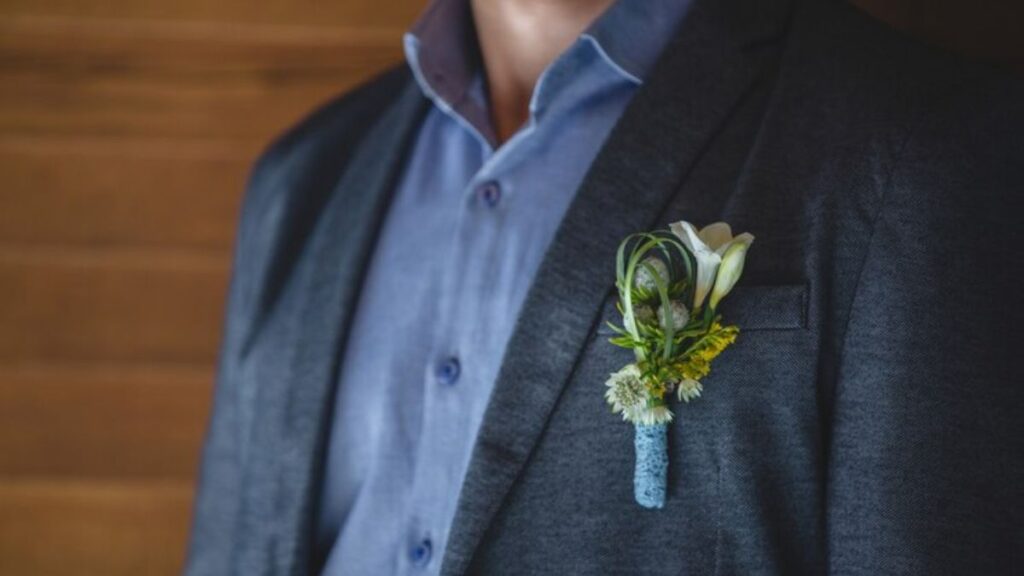Worn with grace, symbolic of tradition, and often a highlight in formal attire, the boutonniere is a small detail that leaves a lasting impression. Whether you’re preparing for a wedding, prom, or formal ceremony, understanding how to select, wear, and appreciate a boutonniere is essential. This guide, “Boutonniere 101,” is your comprehensive source for everything related to this classic accessory—from its rich history to the latest style trends and etiquette rules.
Table of Contents
- Introduction
- What Is a Boutonniere?
- The History of the Boutonniere
- When to Wear a Boutonniere
- Common Types and Flowers Used
- How to Choose the Right Boutonniere
- Boutonniere Etiquette and Placement
- DIY vs. Professional Boutonnieres
- Coordinating Boutonnieres with Attire
- Cultural Significance Around the World
- Preserving and Reusing Boutonnieres
- Mistakes to Avoid with Boutonnieres
- Modern Trends in Boutonniere Styling
- Conclusion
- FAQs
Introduction
The boutonniere—often overlooked—remains one of the most symbolic and elegant finishing touches for men’s formalwear. More than just a flower pinned to a lapel, it conveys emotion, culture, and style. Understanding its role, origins, and design will give you new appreciation for this small yet powerful accessory.
What Is a Boutonniere?
A boutonniere is a small floral arrangement worn on the lapel of a suit or tuxedo jacket. Traditionally pinned to the left lapel above the heart, it symbolizes love, honor, and festivity. Often worn by grooms, prom dates, or in ceremonial events, boutonnieres bring a floral accent to men’s formal fashion.
Unlike corsages—which are worn on the wrist or shoulder—boutonnieres are more subtle, typically featuring one or two blooms. These blooms are backed by greenery and secured with a pin or magnetic fastener.
The History of the Boutonniere
The term “boutonniere” originates from French, meaning “buttonhole flower.” Historically, men wore flowers in their lapel as early as the 16th century. Boutonnieres gained prominence during the 19th century in Europe and were often worn to ward off bad luck or disease.
In Victorian times, the boutonniere symbolized gentlemanly virtue and was a staple at formal events. Royalty, military personnel, and aristocrats frequently adorned their suits with these miniature floral displays.
When to Wear a Boutonniere
Boutonnieres are most commonly worn during formal or semi-formal events. Here are some occasions where they are especially appropriate:
1. Weddings
The groom, groomsmen, fathers of the bride and groom, and other significant male attendees often wear boutonnieres to coordinate with the wedding’s color scheme or floral arrangements.
2. Proms and School Formals
Boutonnieres serve as the male counterpart to a corsage, often exchanged between dates and matched to dresses or tuxedos.
3. Funerals and Memorials
A white flower boutonniere may be worn as a mark of respect or mourning.
4. Military Ceremonies
In some cultures, military personnel wear boutonnieres on ceremonial dress uniforms during parades or commemorative events.
5. Graduation and Awards Ceremonies
Boutonnieres may be worn to signify achievement or celebrate milestones.
Expand your knowledge and check out more posts on our blog!
Common Types and Flowers Used
The type of flower used in a boutonniere often reflects the formality, tone, and style of the event.
Classic Flower Choices
- Rose – Romance, elegance
- Carnation – Timeless, versatile
- Calla Lily – Sophistication
- Orchid – Exotic, luxurious
- Lily of the Valley – Purity, subtlety
- Sunflower or Daisy – Cheerful, rustic-themed weddings
Greenery & Accents
Often, florists incorporate eucalyptus, ferns, baby’s breath, or herbs like rosemary and lavender to enhance texture and fragrance.
How to Choose the Right Boutonniere
Choosing the perfect boutonniere depends on various factors such as the event type, outfit style, personal preference, and coordination with your partner’s attire.
1. Match with Theme or Color
Select blooms that complement the wedding or event’s color scheme. Ensure it doesn’t clash with your outfit.
2. Consider Seasonality
Use flowers that are in season for better freshness and cost-effectiveness.
3. Factor in Scent and Size
Avoid overly fragrant or large flowers that may become a distraction or awkward to wear.
4. Coordinate with Your Partner
Matching elements from your partner’s corsage or bouquet adds a romantic and thoughtful touch.
Boutonniere Etiquette and Placement
Etiquette is crucial when it comes to formal accessories like boutonnieres.
Correct Placement
A boutonniere is traditionally pinned to the left lapel, just above the heart. Most formal jackets have a designated buttonhole for it. If not, a pin or magnet is used discreetly to hold the flower in place.
Who Should Wear One?
- Groom
- Groomsmen
- Fathers and grandfathers of the couple
- Ring bearers
- Special male guests (officiants, readers)
Do Not Overdo
Only select individuals should wear boutonnieres. Too many boutonnieres can dilute their significance.
DIY vs. Professional Boutonnieres
Should you make your own boutonniere or hire a florist?
DIY Pros
- Budget-friendly
- Customization freedom
- Personal touch
DIY Cons
- Time-consuming
- Can lack polish or durability
- Needs basic floral skills
Professional Pros
- Quality craftsmanship
- Coordinated with other floral arrangements
- Less stress
If the event is important (like a wedding), it’s often safer to rely on professional florists for boutonnieres.
Coordinating Boutonnieres with Attire
A boutonniere should enhance your outfit—not overpower it.
1. With Tuxedos
A single white bloom like a rose or calla lily is classic and refined.
2. With Suits
A colorful or textured flower can provide contrast or complement your tie or pocket square.
3. With Casual Attire
Go minimalist with wildflowers or herbs. Keep it small and rustic.
Avoid color conflicts between boutonniere and tie. Harmonize rather than match identically.
Cultural Significance Around the World
Boutonnieres are not just Western fashion elements; they hold meaning globally.
- Philippines – Men wear floral pins during formal town fiestas.
- India – Grooms often wear flower garlands and mini boutonnieres in traditional attire.
- Italy – Known as “fiore all’occhiello,” it’s a classic male fashion accessory during religious or civic events.
- China – Red flowers signify good fortune and are used in wedding attire.
Preserving and Reusing Boutonnieres
Want to keep a boutonniere as a memory?
Preservation Tips
- Hang upside down to dry
- Use silica gel to retain shape and color
- Frame it in a shadow box
- Press in a book for a flat memento
Reuse Options
- Turn dried flowers into bookmarks
- Incorporate into a keepsake wreath
- Use petals in candles or bath bombs
Mistakes to Avoid with Boutonnieres
Boutonniere mishaps can detract from your appearance. Here are common pitfalls:
- Overly Large Designs – Keep it proportional to your body size.
- Wrong Placement – Always pin above the heart.
- Floppy Flowers – Secure tightly and use fresh, sturdy blooms.
- Clashing Colors – Ensure it harmonizes with the overall outfit.
- Too Many Wearers – Limit to essential figures only.
Curious to learn more? Dive into the rest of our blog for helpful tips and insights!
Modern Trends in Boutonniere Styling
As fashion evolves, so do boutonniere styles.
1. Non-Floral Boutonnieres
Use feathers, fabric flowers, charms, or pins for unique alternatives.
2. Succulent Boutonnieres
Durable, eco-friendly, and trendy—perfect for rustic or outdoor weddings.
3. Themed Boutonnieres
Add symbolic items like musical notes, miniature books, or gear-shaped accents for themed events.
4. Eco-Friendly Options
Dried flowers or faux silk blooms reduce waste and can be reused.
5. Magnetic Fasteners
Modern magnetic holders prevent fabric damage and are easier to use than pins.
Conclusion
Though small in size, the boutonniere has a grand history and immense cultural and symbolic weight. Whether it’s a rose at a wedding, a daisy at prom, or a lavender sprig at a memorial, this floral accessory offers timeless elegance and personal expression.
Understanding the traditions, etiquette, and style elements of boutonnieres equips you to wear one with confidence and grace. Make it meaningful, make it stylish, and wear it with pride.
FAQs
1. What is a boutonniere?
A boutonniere is a small floral decoration traditionally worn on the left lapel of a suit or tuxedo during formal events.
2. Who wears a boutonniere at a wedding?
Typically, the groom, groomsmen, fathers, grandfathers, and sometimes special male guests like officiants or ring bearers wear boutonnieres.
3. Can I make my own boutonniere?
Yes, DIY boutonnieres can be made using simple tools and fresh or dried flowers, but professional florists ensure longer-lasting, polished designs.
4. What flowers are best for boutonnieres?
Popular choices include roses, carnations, orchids, and calla lilies. Choose based on season, color coordination, and scent preferences.
5. Do I match my boutonniere with my date’s corsage?
Yes, coordinating (not necessarily matching) your boutonniere with your partner’s corsage enhances visual harmony and shows thoughtful preparation.
We hope you enjoyed reading this article. If you found it helpful, be sure to check out our blog for more informative resources.







